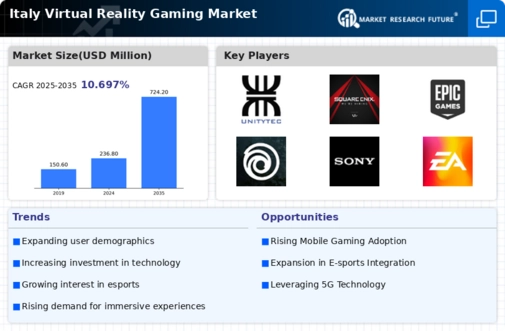Growing Popularity of Esports
The rise of esports in Italy is significantly impacting the virtual reality-gaming market. As competitive gaming gains traction, the demand for immersive gaming experiences increases. VR technology offers unique opportunities for esports, allowing players to engage in more realistic and interactive environments. In 2025, it is estimated that the esports market in Italy will surpass €200 million, with a notable portion attributed to VR gaming. This trend suggests that as more players and spectators embrace VR esports, the overall market for virtual reality gaming will likely expand, attracting investments and fostering innovation.
Expansion of VR Gaming Arcades
The proliferation of VR gaming arcades across Italy is contributing to the growth of the virtual reality-gaming market. These venues provide consumers with access to high-end VR experiences without the need for personal investment in expensive equipment. As of November 2025, there are over 100 VR gaming arcades operating in major cities, attracting both casual gamers and enthusiasts. This trend indicates a shift in consumer behavior, where individuals seek social and immersive gaming experiences. The success of these arcades is likely to encourage further investment in the virtual reality-gaming market, enhancing its visibility and accessibility.
Increased Investment in Gaming Startups
Investment in gaming startups focusing on virtual reality is on the rise in Italy, which is a crucial driver for the virtual reality-gaming market. Venture capitalists and tech incubators are increasingly funding innovative projects that leverage VR technology. In 2025, it is anticipated that investments in Italian gaming startups will exceed €150 million, with a significant share directed towards VR initiatives. This influx of capital not only supports the development of new games but also encourages collaboration between tech companies and game developers, fostering a vibrant ecosystem that propels the virtual reality-gaming market.
Technological Advancements in VR Hardware
The virtual reality-gaming market in Italy is experiencing a surge due to rapid technological advancements in VR hardware. Innovations such as improved graphics, enhanced motion tracking, and more immersive audio systems are making VR experiences more engaging. For instance, the introduction of lightweight headsets with higher resolution displays has attracted a broader audience. In 2025, the market for VR headsets in Italy is projected to reach approximately €500 million, reflecting a growth rate of around 25% annually. This technological evolution not only enhances user experience but also encourages developers to create more sophisticated games, thereby driving the virtual reality-gaming market forward.
Integration of VR in Educational Platforms
The integration of virtual reality technology into educational platforms is emerging as a significant driver for the virtual reality-gaming market in Italy. Educational institutions are increasingly adopting VR to create interactive learning environments, which can also include gamified elements. This trend is expected to enhance student engagement and retention. By 2025, the market for VR in education is projected to reach €100 million in Italy, with a portion of this growth stemming from the gamification of learning experiences. This integration not only broadens the application of VR technology but also introduces new audiences to the virtual reality-gaming market.
























Leave a Comment